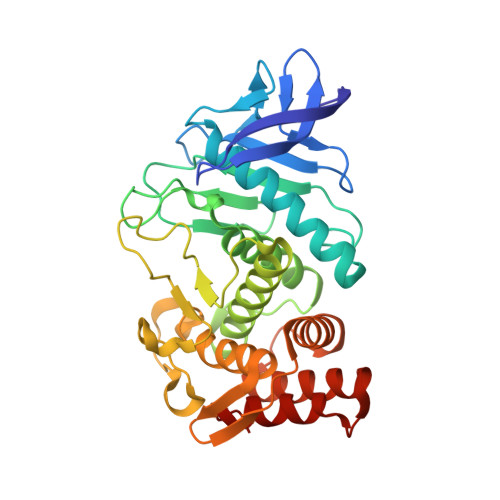Thiorphan and retro-thiorphan display equivalent interactions when bound to crystalline thermolysin
Roderick, S.L., Fournie-Zaluski, M.C., Roques, B.P., Matthews, B.W.(1989) Biochemistry 28: 1493-1497
- PubMed: 2719912
- DOI: https://doi.org/10.1021/bi00430a011
- Primary Citation of Related Structures:
1Z9G, 1ZDP - PubMed Abstract:
The three-dimensional structures of (S)-thiorphan and (R)-retro-thiorphan bound to thermolysin have been determined crystallographically and refined to residuals of 0.183 and 0.187 at 1.7-A resolution. Thiorphan [N-[(S)-2-(mercaptomethyl)-1-oxo-3-phenylpropyl]glycine] [HSCH2CH(CH2C6H5)CONHC-H2COOH] and retro-thiorphan [[[(R)-1-(mercaptomethyl)-2-phenylethyl] amino]-3-oxopropanoic acid] [HSCH2CH(CH2C6H5)NHCOCH2COOH] are isomeric thiol-containing inhibitors of endopeptidase EC 24-11 (also called "enkephalinase"). The mode of binding of thiorphan to thermolysin is similar to that of (2-benzyl-3-mercaptopropanoyl)-L-alanylglycinamide [Monzingo, A.F., & Matthews, B.W. (1982) Biochemistry 21, 3390-3394] with the inhibitor sulfur atom coordinated to the active site zinc and the peptide portion forming substrate-like interactions with the enzyme. The isomeric inhibitor retro-thiorphan, which differs from thiorphan by the inversion of an amide bond, utilizes very similar interactions with enzyme. Despite the inversion of the -CO-NH- linkage the carbonyl oxygen and amide nitrogen display very similar hydrogen bonding, as anticipated by B.P. Roques et al. [(1983) Proc. Natl. Acad. Sci. U.S.A. 80, 3178-3182]. These results explain why thermolysin and possibly other zinc endopeptidases such as endopeptidase EC 24-11 fail to discriminate between these retro-inverso inhibitors.
Organizational Affiliation:
Institute of Molecular Biology, University of Oregon, Eugene 97403.

















